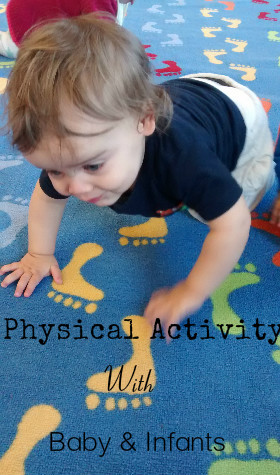I found this nice page from the NHS on physical activity guidelines for children under 5 (walking and non-walking)
Baby containers
Often, it is very easy for baby to spend time being still or strapped in somewhere like, the high-chair, then maybe into the buggy for an outing, then when you get home, maybe into the cot for nap, then into the high-chair again for lunch, into the walker, swing, or bouncer…etc…etc. See this post here from Starfish Therapies for more about this “container shuffle”, as they call it (baby shuffles from one container to the next)
Ok… So How much physical activity do children under 5 years old need to do to keep healthy?
The NHS writes that it is important for babies and infants to be physically active every day for healthy growth and development.
Babies
Babies should be encouraged to be active from birth. Before your baby begins to crawl, encourage them to be physically active by reaching and grasping, pulling and pushing, moving their head, body and limbs during daily routines, and during supervised floor play, including tummy time. Once babies can move around, encourage them to be as active as possible in a safe, supervised and nurturing play environment. For more ideas, see Keeping kids active.
Toddlers
Children who can walk on their own should be physically active every day for at least 180 minutes (3 hours). This should be spread throughout the day, indoors or outside. The 180 minutes can include light activity such as standing up, moving around, rolling and playing, as well as more energetic activity like skipping, hopping, running and jumping. Active play, such as using a climbing frame, riding a bike, playing in water, chasing games and ball games, is the best way for this age group to be physically active.
All children under 5 years old
Children under 5 should not be inactive for long periods, except when they’re asleep. Watching TV, travelling by car, bus or train or being strapped into a buggy for long periods are not good for a child’s health and development
Hah – don’t think my Little Lovely would qualify as being inactive for long periods, he is far too busy exploring and needing to pick up everything he sees to be doing that.
There are also two nicely set out downloads of Physical Activity Guidelines for under 5s who are not yet walking here, and under 5s capable of walking here.
Examples of physical activity for children who are not yet walking includes:
-
‘Tummy time’ – this includes any time spent on the stomach including rolling and playing on the floor
-
Reaching for and grasping objects, pulling, pushing and playing with other people
-
‘Parent and baby’ swim sessions
What are the benefits of movement?
• Develops motor skills
• Improves cognitive development
• Contributes to a healthy weight
• Enhances bone and muscular development
• Supports learning of social skills
What are the benefits of being active for at least 180 minutes each day?
• Improves cardiovascular health
• Contributes to a healthy weight
• Improves bone health
• Supports learning of social skills
• Develops movement and co-ordination


